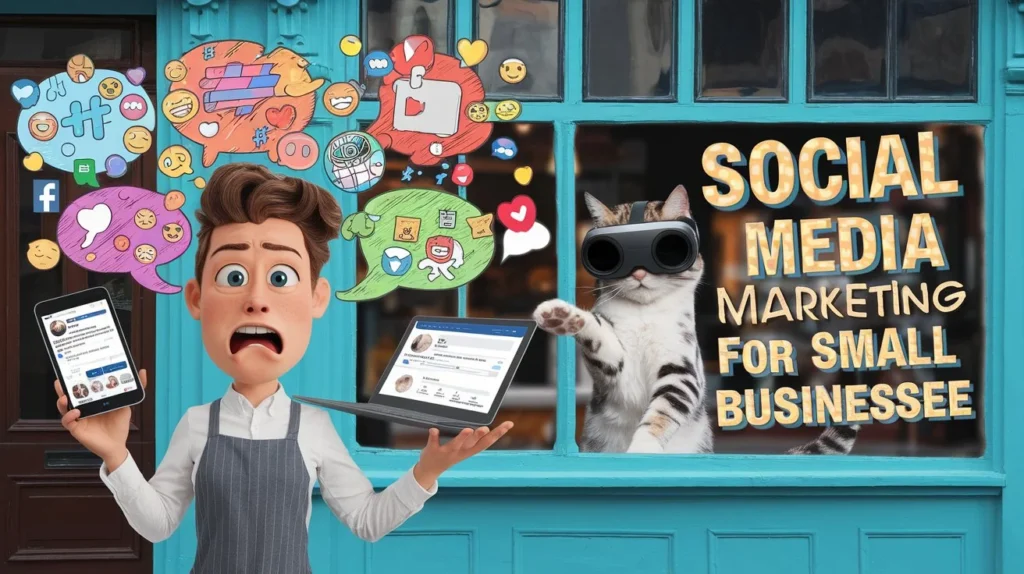To grow your business, focus on effective social media marketing strategies. Start by understanding your target audience and choosing the right social networking platforms. Create engaging content that connects with your customers, like photos, videos, and helpful tips.
Post regularly and interact with your followers to build relationships. Use analytics to track your progress and adjust your strategies.
Don’t forget to stay updated on social media trends and algorithms. Remember, quality content is more vital than quantity.
By following these steps, you’ll be on your way to enhancing your brand awareness and increasing sales. There’s much more to learn about digital marketing your small business effectively. Maximize Business Growth and Online Presence With SoTellUs
Key Points
- Develop a comprehensive social media strategy to build brand awareness and engage many customers cost-effectively.
- Understand your target audience through research and analytics to create tailored content strategies.
- Choose the right social media platforms based on your audience growth and demographics and engagement rates.
- Create diverse, high-quality content including photos, videos, and text to maintain many customers interest.
- Regularly analyze social media metrics and adjust strategies to improve performance and ROI in your particular brand exposure.
Introduction to Social Media Marketing for Small Business
Social media marketing is a transformative force for small businesses, and we’ll investigate why it’s so essential.
We’ll look at the reasons your small business needs a solid social media strategy to succeed in the current online environment.
Ultimately, we’ll introduce you to the “big five” social networking platforms that can help your business grow and connect with customers. Proven Strategies to Skyrocket Real Estate Lead Generation for Realtors
Why social media marketing for small business is important
In the current online environment, small businesses can’t afford to ignore the power of a social media marketing funnel. It’s a key tool for small business marketing that can help us reach more customers and grow our brands. We need to understand why social networks for small business is so essential.
First, it helps us build brand awareness. When we post regularly on social media, more people see our business name and what we offer. This makes it easier for potential customers to find us and remember us.
Second, social media marketing is cost-effective. We don’t need a big budget to start. We can create free accounts on platforms like Facebook, Instagram, and Twitter to connect with our audience.
Third, it allows us to engage directly with customers. We can answer questions, respond to comments, and show our business’s personality. This builds trust and loyalty.
Lastly, social marketers can drive business growth through social media. By sharing worthwhile content and promotions, we can attract new customers and keep existing ones coming back. It’s a powerful way to enhance our sales and expand our reach.
Why your small business needs a social media strategy
A well-crafted social media strategy from a good social media marketing manager is vital for small businesses looking to improve their online presence. We can’t stress enough how significant it’s to have a plan for your social media efforts. Without a strategy, you might waste time and money on posts that don’t reach the right people or achieve your goals.
A small business social media marketing strategy helps you focus on what matters most. It guides you in choosing the right platforms, creating content that connects with your audience, and measuring your success. We’ve seen many businesses grow their customer base and increase sales through smart social media marketing strategies.
To create an effective social commerce for business success plan, start by setting clear goals. Do you want more website visitors? More sales? Better customer service?
Then, figure out who your ideal customers are and where they hang out online. Choose platforms that match your business and audience. Create a content calendar to stay organized, and use tools to schedule posts and track results.
Social media strategy for small business: The big five
Now that we’ve established the importance of a social media strategy, let’s focus on the main platforms you’ll likely utilize. For small business social media, we recommend starting with the “big five”: Facebook, Instagram, Twitter, LinkedIn, and YouTube.
These platforms offer diverse ways to connect with your audience. Facebook is great for building community and sharing updates. Instagram works well for visual content and reaching younger users. Twitter is perfect for quick updates and customer service. LinkedIn is ideal for B2B connections and professional networking. YouTube lets you share video content and tutorials. Mastering PPC and Lead Generation for Plumbing Businesses
To make the most of these platforms, follow these social media marketing tips:
- Create a consistent brand voice across all channels.
- Post regularly to keep your audience engaged.
- Use high-quality images and videos in your content creation.
- Respond promptly to comments and messages.
- Use hashtags to increase visibility.
- Monitor your social media engagement (Social Media KPIs) to see what works.
9 Steps To Use Social Media for Small Business

Let’s look at how small businesses can use a social-media-marketing-strategy effectively.
We’ll cover five crucial steps that will help you get started.
These steps include setting goals, knowing your audience, picking the right platforms, staying up-to-date, and making content people want to see.
Step 1: Identify your goals
Before diving into digital marketing and social media marketing services, identifying your goals is crucial. We must think about what we want to achieve with our social media efforts. Are we trying to get more customers? Do we want to make people aware of our brand? Maybe we want to sell more products online.
It’s significant to write down our social media goals clearly.
Once we recognize our goals, we can create a social media strategy that works for our small business. This strategy will help us choose the right social media platforms and make content that our target audience on social media will like.
A good social media marketing guide can help us understand how to reach the right people.
Step 2: Understand your target audience
Understanding your target audience is a crucial step in developing an effective social media strategy for your small business. We need to know who we’re talking to before we can create content that connects with them.
Let’s start by researching our customers’ demographics, interests, and online behaviors. We can use social media analytics tools to gather this information and gain understanding into our audience’s preferences.
Once we’ve this data, we can create buyer personas to represent our ideal customers. These personas help us tailor our content marketing efforts to specific groups.
We’ll use this information to decide which social media platforms are best for reaching our audience and what type of content they prefer.
Next, we’ll develop a small business content strategy that aligns with our audience’s needs and interests. This might include how-to guides, product demonstrations, or behind-the-scenes glimpses of our business.
By understanding our target audience, we can create content that engages them and encourages them to interact with our brand.
Step 3: Choose the right platforms
With our target audience clearly defined, we can now select the most effective social media platforms for our small business.
We’ll focus on the best social media insights and platforms for business that align with our goals and audience preferences. It’s crucial to choose wisely, as we can’t be everywhere at once.
Let’s start by researching where our target audience spends their time online. We’ll look at demographics, user behavior, and engagement rates for each platform. This will help us narrow down our options.
Once we’ve identified the most promising platforms, we’ll create accounts and start building our presence.
To make our efforts more efficient, we’ll use social media marketing tools. These can help us schedule posts, track engagement, and analyze our performance.
We’ll also apply social media optimization techniques to improve our content’s visibility and reach.
Small business social media tools can be a transformative element for managing multiple platforms.
We’ll investigate options that fit our budget and needs. Ultimately, we’ll follow social media best practices to guarantee we’re using each platform effectively and professionally.
Step 4: Scroll, scroll, scroll
Why is scrolling so vital for small businesses on social media? It’s all about staying up-to-date and engaged. When we scroll through our feeds, we’re keeping an eye on social media trends and learning how to post on social media effectively.
Scrolling helps us understand what content works best for organic social media reach. We can see which posts get the most likes, comments, and shares. This gives us ideas for our own content.
It’s also significant to know how social media algorithms work. These decide what shows up in people’s feeds.
To make the most of scrolling:
- Set aside time each day to scroll through your feeds.
- Pay attention to popular hashtags and topics.
- Look at how other businesses in your field are posting.
- Notice which types of posts get the most engagement.
- Try out new features and formats you see others using.
Step 5: Create engaging content
Now that we’ve perfected the art of scrolling, it’s time to put our observations into practice. Creating engaging content is key to expanding your small business on social media. Let’s investigate how to create engaging content that’ll enhance your online presence.
First, develop a social media content plan. This means deciding what types of posts you’ll make and when you’ll share them. Mix up your content with photos, videos, and text posts to keep things interesting. Use trending topics and hashtags to increase social media engagement.
Next, focus on content marketing for small businesses. Share helpful tips, behind-the-scenes peeks, and customer stories. This builds trust and shows your knowledge. Don’t forget to ask questions and respond to comments to keep the conversation going.
Keep an eye on social media marketing trends. Try new features like Stories or Reels to stay current. Remember, quality beats quantity. It’s better to post less often but with great content than to flood feeds with boring stuff.
Lastly, be authentic and show your brand’s personality. People connect with real, relatable content. With these tips, you’ll create content that engages your audience and helps your business expand.
Step 6: Plan and schedule your content
After creating engaging content, it’s crucial to plan and schedule your posts effectively. Let’s look at how to do this.
Initially, create a social media calendar. This is like a big planner for your posts. It helps you see what you’ll post and when.
Next, think about posting frequency on social media. How often should you post? It depends on the platform, but don’t overdo it. Quality beats quantity to gain a good social presence.
Now, let’s talk about the best times to post on social media. When are your followers online? Use platform analytics to find out. Post when they’re most likely to see your content.
To make this easier, use post scheduling tools. These let you set up posts in advance, so they go out at the right times automatically.
Step 7: Collaborate with creators and other small businesses
Collaboration’s power in social media marketing can’t be overstated. When we team up with creators and other small businesses, we can reach new audiences and grow our online presence faster.
Let’s investigate some social media growth hacks through collaborations.
First, we should identify social media influencers for small business. These are people who’ve a strong following in our industry. We can reach out to them for partnerships or sponsored content. This is called influencer marketing, and it’s a great way to get our brand in front of more people.
Next, we can look for other small businesses to partner with on social media. We might create joint content, run cross-promotions, or even host online events together. This helps both businesses gain exposure to each other’s followers.
To achieve small business social media success, we need to be strategic about our collaborations. We should choose partners whose values align with ours and whose audience would be interested in our products or services.
Step 8: Listen to feedback
The eighth essential step in leveraging social media marketing for small business success is to actively listen to feedback. We need to pay attention to what our customers are saying about us online. This means checking comments, messages, and mentions regularly. It’s not just about reading them, but also responding and taking action.
To do this well, we should use social media metrics. These are numbers that tell us how our posts are doing. We can see how many people like, share, or comment on our content. A social media audit helps us look at all our accounts and see what’s working. We can then focus on what gives us the best social media ROI, or return on investment.
Customer retention through social media marketing is essential. When we listen and respond to feedback, people feel heard. This keeps them coming back.
Social media for customer engagement is about creating a two-way conversation. We can ask questions, run polls, or host live Q&A sessions. This shows we care about what our customers think and want to improve.
Step 9: Study your analytics
Studying your social media marketing analytics is a crucial step in mastering social media for small business success. We need to use social media tracking tools to understand how our efforts are paying off. These tools help us measure our social media performance metrics, which show us what’s working and what’s not.
To track social media success, we should look at things like how many people see our posts, how many likes and comments we get, and how many people click on our links. Social media management platforms can make this easier by putting all our data in one place. We can see which posts are most popular and when our followers are most active.
It’s also significant to keep an eye on our social media marketing advertising costs. We want to make sure we’re getting good value for our money.
By studying our analytics regularly, we can adjust our strategy to get better results. This might mean posting at different times, changing the type of content we share, or targeting our ads more effectively.
Facebook marketing for small business

Let’s investigate how to make the most of Facebook for your small business social media marketing and social presence.
We’ll look at what kinds of posts work best, how often you should share content, and ways to get more people to interact with your page.
These tips will help you use Facebook to grow your business and connect with customers.
What to post
Maneuvering the world of Facebook content can be challenging for small businesses. We need to focus on creating posts that grab attention and encourage interaction.
Let’s look at some social media tips to enhance engagement on social media posts.
First, share a mix of content types. Use photos, videos, and text posts to keep things interesting. Ask questions to get people talking. Share behind-the-scenes glimpses of your business to build trust.
Don’t forget to post about sales or special offers, but don’t overdo it.
To grow on social media, be consistent. Post regularly, but not too much. Once or twice a day is usually good.
Use a social media marketing budget to enhance significant posts. This helps more people see them.
How often to share
Now that we’ve covered what to post in your social media marketing, let’s examine how often small businesses should share content on Facebook. Regarding social media management, consistency is key. We recommend posting at least once a day, but no more than three times daily. This keeps your audience engaged without overwhelming them.
Creating a social media strategy is essential for determining your posting frequency. Consider your target audience‘s habits and when they’re most active on Facebook. Use social media tools to schedule posts in advance, ensuring you maintain a regular presence even during busy times.
To grow your business on social media, it’s significant to experiment with different posting times and frequencies of your social media tactics. Track your engagement rates and adjust accordingly. Remember, quality trumps quantity. It’s better to share one great post than several mediocre ones.
Social media marketing generates visitors but requires patience. Don’t expect instant results. Instead, focus on building relationships with your audience over time.
Respond to comments and messages promptly, and use information from your posts to refine your strategy. With consistent effort and smart planning, you’ll see your Facebook presence grow.
Tips to boost engagement
Five key strategies can greatly improve your Facebook engagement as a small business.
Initially, create content that’s fun and interesting. Use images, videos, and stories that people will want to share.
Secondly, ask questions and start conversations. This makes your followers feel involved and heard.
Third, use Facebook Live to connect with your audience in real-time. It’s a great way to show the human side of your business.
Fourth, run contests or giveaways to get people excited about your brand. Just make sure to follow Facebook’s rules for promotions.
Lastly, use Facebook’s targeting tools to reach the right people with your posts.
These Facebook engagement tips can also work on other platforms.
For Instagram, use relevant hashtags and post at the best times.
On LinkedIn, share industry news and join professional groups.
YouTube engagement tips include making eye-catching thumbnails and using end screens.
For Twitter, retweet interesting content and join trending conversations.
Instagram marketing for small businesses

Let’s examine how small businesses can use Instagram for marketing.
We’ll look at what to post, how often to share content on these online networks, and tips to enhance engagement with your followers on these popular apps.
These strategies will help you make the most of Instagram’s visual platform to grow your business and connect with customers.
What to post
Deciding what to post on Instagram is crucial for small businesses aiming to make an impact on the platform from your successful campaigns. We need to create content that catches people’s attention and shows what our business is about.
Let’s mix different types of posts to keep things interesting. We can share photos of our products, behind-the-scenes glimpses of our work, and customer stories. Videos are great too, especially for showing how to use our products or services.
It’s significant to keep in mind that Instagram is part of a bigger social media strategy. We should think about how our Instagram posts fit with our Facebook marketing and YouTube marketing efforts. This helps create consistent social media campaigns across all platforms.
Don’t forget to follow our social media policy when posting.
We can also use Instagram to show our business’s personality. Share funny moments, celebrate team achievements, or highlight community involvement.
Use hashtags to help people find our posts, and don’t be afraid to ask questions or run contests to get followers engaged.
Keep in mind, the key is to post regularly and stay true to our brand’s voice and values.
How often to share
Determining the ideal posting frequency on Instagram can be a balancing act for small businesses. We need to share content often enough to stay relevant, but not so much that we overwhelm our followers. A good starting point is to post once a day, preferably at a time when our audience is most active.
Using free social media tools, we can track when our followers are online and schedule our posts accordingly. This consistency helps in building a social media audience. As we grow, we might increase our posting frequency to two or three times a day.
It’s crucial to keep in mind that quality trumps quantity. We shouldn’t post just for the sake of posting. Each piece of content should add value to our followers. This approach is key in social media advertising for small business.
We can also mix up our content types. Sharing regular posts, stories, and reels keeps our feed interesting. These small business marketing tactics help maintain engagement without bombarding followers.
Tips to boost engagement
Enhancing engagement on Instagram is crucial for small businesses looking to grow their online presence. We need to focus on creating content that our followers want to see and interact with.
Initially, let’s use high-quality photos and videos that catch people’s attention. We should also write captions that ask questions or encourage comments. This way, our followers will want to respond.
It’s significant to use hashtags that are relevant to our business and industry. This helps new people find our content.
We can also try Instagram Stories and Reels to show different sides of our business. These features are great for sharing behind-the-scenes content or quick tips.
We shouldn’t forget about paid options like elevating social media posts or using Facebook ads for small businesses. These can help us reach more people, even with a small social media budget.
If we’re feeling adventurous, we can investigate TikTok marketing tips to expand our reach on another platform.
Lastly, we should always respond to comments and messages promptly. This shows we care about our followers and helps build strong relationships with them.
LinkedIn marketing for small business

Let’s talk about how to use LinkedIn for your small business.
We’ll cover what kind of posts work best, how often you should share them, and some tips to get more people to interact with your content.
These strategies will help you make the most of LinkedIn’s professional network and grow your business connections.
What to post
LinkedIn’s power for small businesses lies in the content they share. We need to post smart to get noticed. Let’s talk about what to put on LinkedIn for small business success.
First, share helpful tips about your industry. People like learning new things. Write short posts with clear advice. It’s different from how to post on Facebook, which is more casual.
Next, show off your work. Post images or videos of your products or happy customers. This works well on Instagram ads for small businesses too.
Don’t forget to share news about your company. Did you win an award? Hire someone new? Tell people about it!
Ask questions to get people talking. It’s a great way to learn what your customers think.
Lastly, share interesting articles about your field. Add your thoughts to start a conversation.
How often to share
Consistent posting is key to LinkedIn success for small businesses. We recommend sharing content 2-3 times per week on LinkedIn. This keeps your profile active without overwhelming your followers. Remember, quality matters more than quantity.
For Twitter marketing, the pace is faster. Tweet 3-5 times daily to stay visible in users’ busy feeds. Mix up your content with original posts, retweets, and replies to engage your audience.
When it comes to social media marketing on Facebook, aim for 1-2 posts per day. This helps maintain a steady presence without flooding your followers’ timelines. Use a mix of text, images, and videos to keep things interesting.
For YouTube, small businesses should try to upload at least one video per week. Consistency helps build an audience and improves your channel’s visibility in search results.
Lastly, when thinking about how to post on Twitter, focus on timing. Schedule your tweets for when your audience is most active, typically during business hours or early evenings.
Tips to boost engagement
Once you’ve established a consistent posting schedule, it’s time to focus on enhancing engagement for your LinkedIn marketing efforts. We can increase interaction by using eye-catching visuals, asking questions, and sharing useful content.
It’s essential to respond quickly to comments and messages, showing we’re active and care about our audience.
We can also try paid social media campaigns on LinkedIn to reach more people. While we’re focusing on LinkedIn, it’s good to know that other platforms like TikTok can help small businesses expand too. Effective TikTok ads and small business growth on TikTok strategies might be worth exploring later.
For now, let’s stick to LinkedIn. We should use hashtags wisely, join relevant groups, and engage with others’ posts.
It’s also smart to cross-promote our LinkedIn content on other platforms. For example, we can learn how to post on Instagram and share our LinkedIn articles there.
Twitter marketing for small business

Let’s investigate how small businesses can use Twitter effectively.
We’ll cover what types of content to post, how often you should share updates, and some tips to get more people to interact with your tweets.
These strategies will help you make the most of Twitter for your small business marketing efforts.
What to post
For effective Twitter marketing, small businesses should focus on creating engaging and useful content. It’s essential to think about what our followers want to see. Sharing tips, behind-the-scenes peeks, and industry news can keep people interested.
It’s also smart to use eye-catching images and short videos. We can learn from other platforms too. For example, TikTok ads best practices often include catchy music and quick edits. When we create TikTok ad content, we use trends and popular hashtags. These ideas can work on Twitter too.
Remember, Twitter moves fast, so post often but not too much. Don’t forget to interact with others. Reply to comments and join conversations. This helps build relationships.
We can use tools like Hootsuite for small business to plan our posts and track how well they do. Lastly, we can share links to our other content. If we understand how to post on YouTube, we can tweet links to our videos. This helps more people find our stuff across different platforms.
How often to share
Now that we’ve covered what to post, we need to address how often to share content on Twitter for small business marketing. The key is to find a balance. You don’t want to overwhelm your followers, but you also don’t want to be forgotten.
A good rule of thumb is to tweet 3-5 times a day. This keeps your brand visible without being annoying. Space out your tweets throughout the day to reach people in different time zones. You can use tools like Sprout Social for small business or Buffer for small business to schedule your tweets in advance.
It’s also significant to mix up your content. Don’t just promote your products. Share industry news, tips, and fun facts. This variety keeps your followers interested.
Remember, Twitter isn’t the only platform for small businesses. You might also want to investigate LinkedIn ads for small businesses, YouTube ads for small businesses, or even small business TikTok ads.
Consistency is essential. It’s better to tweet regularly than to have bursts of activity followed by long silences. Stick to a schedule that works for you and your audience.
Tips to boost engagement
Engagement is the lifeblood of successful Twitter marketing for small businesses. To enhance it, we need to focus on creating content that people want to interact with.
Initially, use eye-catching images and short videos in your tweets. These grab attention quickly, just like TikTok ad campaigns do. Ask questions in your tweets to start conversations. This gets people talking and sharing their thoughts.
Use hashtags wisely. Pick a few relevant ones to help people find your tweets. Don’t overdo it, though. Too many hashtags look messy.
Respond to comments and mentions fast. This shows you’re listening and care about what people say. It’s like TikTok ad optimization, where you adjust based on feedback.
Try polls and surveys. People love sharing their opinions. This is a great way to learn about your followers, similar to studying TikTok ad metrics.
Share behind-the-scenes content of your business. This makes your brand feel more human and relatable.
Lastly, use tools like Later for small business to plan and schedule your tweets. This helps you stay consistent, which is key for keeping followers engaged.
YouTube marketing for small business
Let’s investigate YouTube marketing for small businesses, focusing on what to post, how often to share, and tips to enhance engagement.
We’ll look at the types of videos that work well for small businesses, discuss a posting schedule that can help you expand your channel, and share some practical ways to elevate viewer interaction.
These strategies can help you make the most of YouTube’s potential to reach new customers and grow your business.
What to post
In regards to YouTube marketing for small businesses, deciding what content to post is crucial for success. We need to think about what our viewers want to see and what’ll help our business grow.
Let’s start by looking at what’s popular on other platforms like TikTok.
TikTok ad A/B testing shows us what kinds of videos people like. We can use this idea on YouTube too. We should try different types of videos and see which ones get the most views.
It’s also smart to avoid common TikTok ad mistakes when making YouTube content. For example, don’t make videos that are too long or boring.
Sequential advertising on TikTok teaches us to tell a story over several videos. We can do this on YouTube by making a series of related videos.
When setting up TikTok ads, businesses use custom audiences. On YouTube, we can also target specific groups of people who might like our products or services.
How often to share
Determining the ideal frequency for sharing content on YouTube is crucial for small businesses looking to improve their marketing efforts. We recommend posting at least once a week to keep your audience engaged and grow your channel.
Consistency is key, so choose a schedule you can stick to. For example, you might decide to upload every Tuesday at 3 PM.
Quality matters more than quantity, so don’t rush to create subpar content just to meet a deadline. It’s better to post less often but maintain high standards. As your channel grows, you can increase your posting frequency.
Remember to promote your videos on other platforms. Share them on your website, social media, and even through email marketing. You can also use TikTok retargeting to reach viewers who’ve engaged with your content before.
Pay attention to your analytics to see when your audience is most active. This will help you choose the best times to post.
Experiment with different posting schedules and track your results to find what works best for your business.
Tips to boost engagement
Engagement is the lifeblood of any successful YouTube channel. To enhance it, we need to focus on creating content that grabs attention and keeps viewers watching.
Initially, let’s make sure our titles and thumbnails are eye-catching. They’re the primary things people see, so they need to stand out. We should use bright colors, clear text, and interesting images.
Next, we’ll work on our video intros. They should be short and exciting, telling viewers what to expect. We can also ask questions or use cliffhangers to keep people interested.
Throughout our videos, we should speak clearly and with energy. It’s essential to look at the camera, like we’re talking to a friend.
We can enhance engagement by asking viewers to like, comment, and subscribe. But let’s not overdo it. Instead, we’ll encourage comments by asking questions or starting discussions.
We can also create polls or quizzes to get people involved. Responding to comments is vital too. It shows we care about our audience and helps build a community around our channel.
5 Best Social Media Tools for Small Businesses

Social media tools can revolutionize how small businesses connect with their audience and grow their brand. We’ve found several tools that are perfect for small businesses.
Let’s start with Hootsuite, which helps you manage multiple social media accounts from one dashboard. It’s great for scheduling posts and tracking engagement.
Next, we recommend Canva for creating eye-catching graphics. It’s easy to use, even if you’re not a designer.
For analytics, Buffer Analyze gives you perspectives into your social media performance. This helps you understand what content works best.
Don’t forget about MailChimp for email marketing. It integrates with social media platforms, making it easier to reach your audience.
Sprout Social is another fantastic tool for managing customer interactions and monitoring your brand.
For video content, TikTok is becoming increasingly popular. It’s a great way to showcase your products or services in short, fun videos.
Lastly, consider using Later for Instagram planning. It helps you create a cohesive feed and schedule posts in advance.
These tools can help small businesses make the most of their social media efforts without breaking the bank.
Hootsuite
We’ve talked about several social media tools, but let’s focus on Hootsuite, a popular choice for many businesses.
While Hootsuite offers its own set of features, it’s worth comparing it to native platform tools, Later, Sprout Social, and Buffer.
Each of these options has unique strengths, so we’ll examine how Hootsuite stacks up against them for managing your social media presence.
Native platform tools
How can businesses streamline their social media management? One effective way is by using native platform tools. These are the built-in features that come with each social media platform.
We’ll find these tools right inside apps like Facebook, Instagram, and Twitter. They’re free and easy to use. For example, Facebook’s Business Suite lets us schedule posts, respond to messages, and see how our content is doing.
On Instagram, we can use analytics to track our followers and see which posts they like best.
Native tools have some big advantages. They’re always up-to-date with the latest platform changes. We don’t need to pay for extra software. And they often work faster than third-party tools.
To get started, we should investigate each platform’s settings and features. We’ll find options to create content, schedule posts, and evaluate our results.
Later
While native tools offer many benefits, some businesses need more advanced features for managing multiple social media accounts. That’s where Later comes in. It’s a tool that helps us plan and schedule our social media posts across different platforms.
Later is great for visual content, especially on Instagram. We can upload our photos and videos, then drag and drop them onto a calendar to plan our posts. It also lets us see how our feed will look before we post, which is really helpful for keeping our Instagram profile looking nice.
One of the best things about Later is that it suggests good times to post based on when our followers are most active. This means more people are likely to see and engage with our content.
We can also use Later to find and repost content from other users, which is a great way to connect with our community.
Later offers some free features, but for more advanced tools, we’ll need to pay for a subscription. It’s a good choice for businesses that want to grow their social media presence.
Sprout Social
Another powerful tool for managing multiple social media accounts is Sprout Social, which is often compared to Hootsuite. This platform offers a user-friendly interface that makes it easy to schedule posts, track engagement, and analyze your social media performance. We can use Sprout Social to manage accounts on popular networks like Facebook, Twitter, Instagram, and LinkedIn.
One of Sprout Social’s standout features is its Smart Inbox, which combines messages from all your social media accounts into one place. This helps us respond to comments and messages quickly. The platform also offers detailed reports that show how well our posts are doing and who’s interacting with them.
Sprout Social has a calendar view for scheduling posts, making it simple to plan content ahead of time. It also suggests the best times to post based on when your followers are most active.
For businesses working in teams, Sprout Social offers collaboration tools that let multiple people work on social media tasks together. While it may be pricier than some alternatives, many users find its features worth the cost.
Buffer
Although often grouped with Hootsuite, Buffer stands out as a distinct social media management tool with its own unique features. We find Buffer particularly useful for its simple, intuitive interface and focus on content scheduling. It’s great for planning posts across multiple platforms like Facebook, Twitter, and Instagram.
One of Buffer’s standout features is its content calendar, which lets us visually plan our social media strategy. We can easily drag and drop posts to rearrange them, ensuring a balanced mix of content throughout the week.
Another helpful tool is Buffer’s analytics, which shows us how our posts are performing. This data helps us adjust our strategy and create better content.
Buffer also offers a browser extension, making it easy to share interesting articles or images we find while surfing the web. We can quickly add these to our content queue without interrupting our workflow.
For businesses just starting with social media, Buffer’s free plan is a great way to test the waters. As your needs grow, you can upgrade to paid plans with more features and support for larger teams.
Tips and Social Media Marketing For Small Business

Let’s examine some advanced social media tips for small businesses.
We’ll look at how to post transparently, use humor effectively, choose trends wisely, and enhance engagement.
These strategies can help you stand out and connect better with your audience on social platforms.
Post transparently
Transparency in social media posting has become a crucial strategy for small businesses aiming to build trust and credibility with their audience. We need to be open and honest about our products, services, and business practices. This means sharing both successes and challenges with our followers.
When we make mistakes, we should own up to them and explain how we’re fixing the issue. Let’s use social media to give our customers a behind-the-scenes look at our business. We can share photos or videos of our team at work, or show how we make our products. This helps people feel connected to our brand.
We should also be clear about our pricing, policies, and any changes we make to our business. It’s significant to respond to customer comments and questions quickly and honestly. If we don’t know an answer, we should say so and promise to find out.
We can also ask for feedback and show how we use it to improve our business. By being transparent, we build trust with our customers and create a loyal community around our brand.
Be hilarious
Humor can be a powerful tool in your social media marketing arsenal. It helps us connect with our audience and make our brand more likable. But being funny online isn’t always easy. We need to be careful and smart about it.
First, know your audience. What makes them laugh? What’s off-limits? Use this info to create jokes they’ll enjoy. Keep it clean and avoid sensitive topics. It’s better to be safe than sorry.
Next, try different types of humor. Puns, memes, and witty observations can work well. Don’t force it, though. If you’re not naturally funny, get help from someone who is.
Timing matters too. Post your funny content when your followers are most active. This increases the chances of people seeing and sharing it.
Remember, not every post needs to be hilarious. Mix funny posts with serious ones. This balance keeps your feed interesting and professional.
Lastly, be ready to laugh at yourself. If a joke falls flat, acknowledge it. Your followers will appreciate your honesty.
Pick your trends wisely
While humor can be a great asset, staying current is just as essential in social media marketing. We need to pick our trends wisely to make sure our content stays relevant and engaging. Not every trend will fit our brand or message, so it’s significant to be selective.
First, we should keep an eye on popular hashtags and topics in our industry. We can use tools like Google Trends or social media listening platforms to track what’s hot. When we spot a trend that aligns with our business, we can create content around it.
It’s imperative to act fast when jumping on trends. They often have a short lifespan, so we need to be ready to create and post content quickly. However, we shouldn’t force it. If a trend doesn’t feel right for our brand, it’s okay to skip it.
We should also consider our audience when picking trends. What interests them? What’re they talking about? By focusing on trends that matter to our followers, we’ll create content they’re more likely to engage with and share.
Tips to boost engagement
To improve engagement on social media, we’ve got to go beyond basic posting strategies.
Let’s focus on some practical tips that can increase your interactions. Initially, ask questions in your posts. This invites your followers to share their thoughts and experiences.
Next, use eye-catching visuals like photos, videos, or infographics. These grab attention and are more likely to be shared.
Don’t forget to respond to comments quickly. This shows you’re listening and care about your audience.
Try running contests or giveaways to encourage participation. People love free stuff!
Also, use hashtags wisely to reach a wider audience interested in your topics.
Live videos are great for real-time engagement. They let you interact directly with viewers.
Share behind-the-scenes content to give followers a peek into your business. This builds trust and connection.
Lastly, post at times when your audience is most active. Use analytics tools to figure out these peak times.
Tracking and Measuring Marketing in Social Media Success

We’ll now investigate how to track and measure our social media success.
Initially, we’ll look at key metrics that tell us if our efforts are working.
Then, we’ll walk through a simple 6-step process to audit our social media performance, including a helpful template to guide us.
Measuring success: Key metrics to watch from social media marketing services
As businesses increasingly rely on social media for marketing and customer engagement, tracking and measuring success becomes vital. We need to focus on key metrics that tell us if our efforts are working.
Initially, let’s look at reach and impressions. These show how many people see our content. Next, engagement rates matter. This includes likes, comments, and shares. They tell us if people find our posts interesting.
We should also track click-through rates. This shows if people are visiting our website from social media. Conversion rates are significant too. They tell us if social media leads to sales or sign-ups.
Don’t forget about follower growth. A steady increase in followers means our audience is growing.
Response times are key for customer service. We should aim to reply quickly to messages and comments.
Ultimately, let’s monitor brand mentions and sentiment. This helps us understand what people are saying about our brand.
How to Do a Social Media Audit in 6 Steps
Building on our understanding of key social media metrics, it’s time to conduct a thorough social media audit. This process helps us see how well our social media efforts are working.
Let’s break it down into six easy steps:
- List all your social media accounts. Include active and inactive ones.
- Gather basic info for each account. Note followers, posts, and engagement rates.
- Check your branding. Make sure your profile images, bios, and links are up-to-date.
- Look at your content. What posts get the most likes and shares?
- Analyze your audience. Who follows you? Are they your target customers?
- Review your goals. Are you meeting them? If not, why?
Use a simple template to keep track of this info. It can be a spreadsheet with columns for each step. Fill it out as you go through the audit.
FAQs
How often should a business post when marketing on social media?
Moving from FAQs to social media strategies, let’s address a common question many businesses face: how often should they post on social media? In 2024, the answer isn’t one-size-fits-all, but we can offer some guidelines.
For most platforms, posting 1-2 times per day is a good start. On Twitter, you can post more often, up to 3-5 times daily. Instagram works well with 1-3 posts per day, while LinkedIn benefits from 1-2 posts per week.
Remember, quality beats quantity. It’s better to share one great post than several mediocre ones. Your content should be useful, interesting, or entertaining to your audience.
Use a content calendar to plan your posts. This helps you stay consistent and avoid last-minute scrambling. Mix up your content types: use images, videos, polls, and text posts to keep things fresh.
Pay attention to when your audience is most active. Use platform analytics to find the best times to post. Adjust your strategy based on what works. If you notice certain types of posts or times get more engagement, do more of that.
How can businesses measure the success of their social media campaigns?
Social media success isn’t just about posting content; it’s about measuring its impact. We need to look at several key metrics to understand how well our campaigns are doing.
Initially, let’s check engagement rates. This means counting likes, comments, and shares on our posts. More engagement usually means our content is resonating with our audience.
Next, we should track our follower growth. Are more people following us over time? This can show if our content is attracting new fans.
We also want to look at reach and impressions. Reach tells us how many unique users saw our posts, while impressions show how many times our posts were displayed.
It’s essential to monitor click-through rates too. This shows how many people are clicking on links in our posts. If we’re trying to drive traffic to our website, this is vital.
Lastly, we should use tools like Google Analytics to see how much social media traffic is converting into leads or sales on our site.
What’s the best social media platform for small businesses?
There’s no one-size-fits-all answer to the best social media platform for small businesses. Instead, we need to evaluate what each platform offers and how it aligns with our business goals.
Let’s look at some popular options.
Facebook is great for reaching a wide audience. It’s good for sharing updates, photos, and videos. We can also use it to create a business page and run ads.
Instagram works well for businesses with visual products. It’s perfect for sharing eye-catching photos and short videos. We can use hashtags to reach more people.
LinkedIn is ideal for B2B companies. It’s a professional network where we can connect with other businesses and potential clients.
Twitter is good for quick updates and customer service. We can use it to share news and engage with customers in real-time.
To choose the best platform, we need to think about our target audience. Where do they spend their time online? What kind of content do they like?
We should also evaluate our resources. How much time can we spend on social media? It’s better to focus on one or two platforms and do them well, rather than trying to be everywhere at once.
Get Business Growth Without Social Media Marketing Courses
We’ve covered a lot about marketing on social media for small businesses. Remember, it’s all about picking the right platforms, creating good content, and engaging with your audience.
Start with one or two networks, post regularly, and track your results. Don’t be afraid to try new things and adjust your strategy. With time and effort, you’ll see your online presence grow. Keep learning and stay up-to-date with social media trends to stay ahead of the game. If you get stuck, then reach out to SoTellUs, and you can get better results than by filling your life with social media marketing courses.

